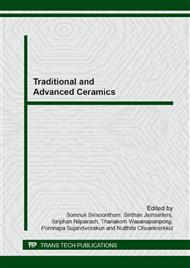p.153
p.159
p.164
p.170
p.175
p.181
p.187
p.193
p.200
A Study of Alumina Spray Dried Granules on Packing Density and Sintering Shrinkage of Simple and Complex Shape
Abstract:
The relationship between granule property, pressed green density and shrinkage of 92% alumina spray dried granules were studied for both simple and complex shapes. Two types of granules, the in-house granule (A) and the commercial granule (B), was observed morphology using microscopy and liquid immersion techniques. Examination of the granules showed that granule A have several undesirable features; agglomeration, hollow granules and non-spherical granules where granule B showed them to be unagglomerated and spherical. The mixture A and B were conducted to study the particle size distribution (PSD) and compared with Dinger-Funks ideal PSD. The result showed that granule mixture A: B 100:0 had closest PSD curve fitted but had lowest tapping and pressed green density than 70:30 and 30:70 mixtures. This is because the agglomerated shape in granule mixture 100:0 caused air gap in between granule contact resulting in low tap density. The specific fracture strengths of the granules can affect to the densification of green ceramic during pressing. Low pressed green density affected to a high amount of shrinkage during sintering and leading to small grain growth after sintered. The simple and complex shape follows the same trend in shrinkage.
Info:
Periodical:
Pages:
175-180
Citation:
Online since:
April 2014
Authors:
Keywords:
Price:
Сopyright:
© 2014 Trans Tech Publications Ltd. All Rights Reserved
Share:
Citation:


